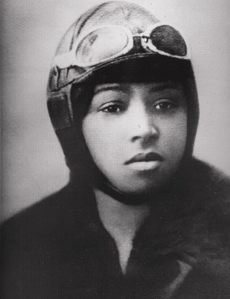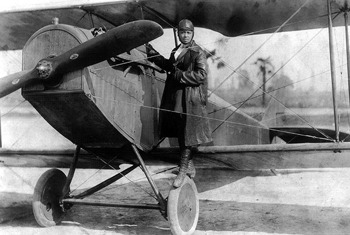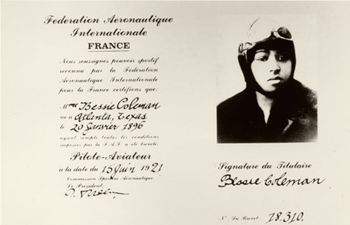|
Bessie Coleman
Answer
to Name
This Famous Person Game - March 2016
by Mike McLeod
|
 |
Bessie Coleman was the first African American woman to earn her pilot’s license. In fact, she was the first of all African Americans to earn a license. Further, Bessie was awarded her international pilot’s license six months before Amelia Earhart earned her U.S. pilot’s license and about two years before she earned her international license.
Born on January 26, 1892 in Atlanta, Texas, into a sharecropping family with 13 kids, Bessie grew up with a desire to make her mark on life. Bessie’s father left the family early on so life was a struggle for the family. Education was sparse; yet, she learned to read and write, and she often read to her family members who could not, including her mother. She did attend one year of college but quit when there were no funds to go on.
moved to Chicago and lived with brothers while working as a manicurist. Hearing stories from pilots returning from World War I, she decided she was going to fly—which was thought to be unimaginable if not impossible at the time.
|

Bessie Coleman, the first African American aviator.
|
Due to discrimination, no flying school or pilot in the U.S. would train her. Fortunately, Bessie learned she could learn to fly in France where her race would not matter. Speaking the language would, however, so Bessie attended a language class and learned French.
With her own money and the sponsorship of benefactors, she sailed to Europe and traveled to northern France to take classes at the Caudron Brother's School of Aviation. Arriving, she must have felt a thrill of accomplishment—and some of her class members must have been shocked to see an African American woman who wanted to fly.
Learning to fly in those early days of aviation was fraught with danger. Bessie learned to fly in a “…27-foot biplane that was known to fail frequently, sometimes in the air. During her training Coleman witnessed a fellow student die in a plane crash, which she described as a ‘terrible shock’ to her nerves.”1 Even so, she persevered, and on June 15, 1921 she achieved her dream when she earned her pilot’s license from the Fédération Aéronautique Internationale.
|

|

|
|
Bessie Coleman with her plane in 1922.
|
Bessie Coleman’s French international pilot’s license.
|
When Bessie left America, she went unnoticed. Returning, she was met by crowds and the media. What she had done was historic.
It wasn’t enough, however, for her to earn a living by flying. There were very few U.S. airlines in those days, and there was no hope of being hired by them. For Bessie to make a career of flying, she knew she had to become a barnstormer. For that to happen, she needed more training so she headed back to France.
Upon her return, Bessie Coleman became a daredevil barnstormer, performing difficult stunts and maneuvers in the old biplanes she used. The crowds loved her, as did the media, calling her “Queen Bess” because of her dominating style of performance and her dominating personality. Some said she bragged about here skills, but baseball legend Dizzy Dean has said, “It ain’t bragging if you can back it up.”
For several years, Bessie performed with success while risking her life every time she climbed into a cockpit. After some initial financial success, she was able to get a used airplane, but on the way to her first performance in it, the plane malfunctioned and crashed. After several weeks of recovery, Bessie was back in the air.
In addition to her accomplishment of attaining her pilot’s license, Bessie Coleman was a woman of principle. She refused to perform at segregated venues or where blacks and whites had separate entrances.2
On April 30, 1926, Bessie and her mechanic took to the air in Florida on a scouting mission for her barnstorming act to find a place where she could parachute from her plane. Even though it was recently purchased (with the help of friends), this plane had experienced mechanic problems on its way to Bessie. With her mechanic flying, Bessie unbuckled her seatbelt to lean out over the open cockpit and look at the ground. At a fatal moment, the plane went into a diving spin, and Bessie was thrown out hundreds of feet from the ground. She died instantly, and her pilot died on impact. Later, a wrench left in the engine compartment was found lodged in the gears.
At the age of 34, Bessie Coleman’s life accomplishments moved into the history books. She was mourned by thousands.
In 1995, the U.S. Post Office issued a Bessie Coleman 32¢ stamp, and in 2006, Bessie joined Charles Lindberg, Amelia Earhart, astronauts and many others in the National Aviation Hall of Fame.
From a sharecropper’s daughter to the first female African-American flyer, Bessie Coleman is a symbol of undaunted determination, of bravery, and of how dreams can come true.
Ted Carlton of Utah and Ginnie Torbert of Hurtsboro Ala., correctly identified Bessie Coleman.
-----------------------------------------
1 PBS.org, American Experience, People & Events, “Bessie Coleman (1892 -1926).”
2 Bessiecoleman.com
Credit:
Biography.com
Learn
about more Famous People
|